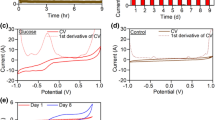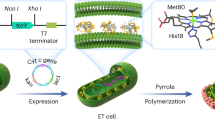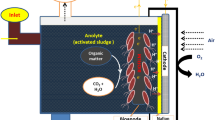Abstract
Significant effort is currently focused on microbial fuel cells (MFCs) as a source of renewable energy. Most studies concentrate on operation at mesophilic temperatures. However, anaerobic digestion studies have reported on the superiority of thermophilic operation and demonstrated a net energy gain in terms of methane yield. As such, our studies focused on MFC operation and microbiology at 55 °C. Over a 100-day operation, these MFCs were stable and achieved a power density of 37 mW m−2 with a coulombic efficiency of 89%. To infer activity and taxonomic identity of dominant members of the electricity-producing community, we performed phylogenetic microarray and clone library analysis with small subunit ribosomal RNA (16S rRNA) and ribosomal RNA gene (16S rDNA). The results illustrated the dominance (80% of clone library sequences) of the Firmicutes in electricity production. Similarly, rRNA sequences from Firmicutes accounted for 50% of those taxa that increased in relative abundance from current-producing MFCs, implying their functional role in current production. We complemented these analyses by isolating the first organisms from a thermophilic MFC. One of the isolates, a Firmicutes Thermincola sp. strain JR, not only produced more current than known organisms (0.42 mA) in an H-cell system but also represented the first demonstration of direct anode reduction by a member of this phylum. Our research illustrates the importance of using a variety of molecular and culture-based methods to reliably characterize bacterial communities. Consequently, we revealed a previously unidentified functional role for Gram-positive bacteria in MFC current generation.
Similar content being viewed by others
Log in or create a free account to read this content
Gain free access to this article, as well as selected content from this journal and more on nature.com
or
Accession codes
References
Aelterman P, Rabaey K, Pham HT, Boon N, Verstraete W . (2006). Continuous electricity generation at high voltages and currents using stacked microbial fuel cells. Environ Sci Technol 40: 3388–3394.
Bond DR, Holmes DE, Tender LM, Lovley DR . (2002). Electrode-reducing microorganisms that harvest energy from marine sediments. Science 295: 483–485.
Bond DR, Lovley DR . (2003). Electricity production by Geobacter sulfurreducens attached to electrodes. Appl Environ Microbiol 69: 1548–1555.
Bretschger O, Obraztsova A, Sturm CA, Chang IS, Gorby YA, Reed SB et al. (2007). Current production and metal oxide reduction by Shewanella oneidensis MR-1 wild type and mutants. Appl Enviro Microbiol 73: 7003–7012.
Brodie EL, DeSantis TZ, Joyner DC, Baek SM, Larsen JT, Andersen GL et al. (2006). Application of a high-density oligonucleotide microarray approach to study bacterial population dynamics during uranium reduction and reoxidation. Appl Enviro Microbiol 72: 6288–6298.
Brodie EL, DeSantis TZ, Parker JPM, Zubietta IX, Piceno YM, Andersen GL . (2007). Urban aerosols harbor diverse and dynamic bacterial populations. PNAS 104: 299–304.
Chaudhuri SK, Lovley DR . (2003). Electricity generation by direct oxidation of glucose in mediatorless microbial fuel cells. Nat Biotech 21: 1229–1232.
Coates JD, Phillips EJ, Lonergan DJ, Jenter H, Lovley DR . (1996). Isolation of Geobacter species from diverse sedimentary environments. Appl Environ Microbiol 62: 1531–1536.
Collins G, Mahony T, O’Flaherty V . (2006). Stability and reproducibility of low-temperature anaerobic biological wastewater treatment. FEMS Microbiol Ecol 55: 449–458.
DeSantis T, Brodie E, Moberg J, Zubieta I, Piceno Y, Andersen G . (2007). High-density universal 16S rRNA microarray analysis reveals broader diversity than typical clone library when sampling the environment. Microb Ecol 53: 371–383.
DeSantis TZ, Hugenholtz P, Larsen N, Rojas M, Brodie EL, Keller K et al. (2006). Greengenes, a chimera-checked 16S rRNA gene database and workbench compatible with ARB. Appl Environ Microbiol 72: 5069–5072.
Duineveld BM, Kowalchuk GA, Keijzer A, van Elsas JD, van Veen JA . (2001). Analysis of bacterial communities in the rhizosphere of chrysanthemum via denaturing gradient gel electrophoresis of PCR-amplified 16S rRNA as well as DNA fragments coding for 16S rRNA. Appl Enviro Microbiol 67: 172–178.
Fernandez AS, Hashsham SA, Dollhopf SL, Raskin L, Glagoleva O, Dazzo FB et al. (2000). Flexible community structure correlates with stable community function in methanogenic bioreactor communities perturbed by glucose. Appl Enviro Microbiol 66: 4058–4067.
Flanagan JL, Brodie EL, Weng L, Lynch SV, Garcia O, Brown R et al. (2007). Loss of bacterial diversity during antibiotic treatment of intubated patients colonized with Pseudomonas aeruginosa. J Bacteriol 45: 1954–1962.
Gorby YA, Yanina S, McLean JS, Rosso KM, Moyles D, Dohnalkova A et al. (2006). Electrically conductive bacterial nanowires produced by Shewanella oneidensis strain MR-1 and other microorganisms. PNAS 103: 11358–11363.
Gralnick JA, Newman DK . (2007). Extracellular respiration. Mol Microbiol 65: 1–11.
Hamid Rismani-Yazdi ADC, Burk AD, Mark M, Zhongtang Yu, Olli HT . (2007). Electricity generation from cellulose by rumen microorganisms in microbial fuel cells. Biotechnol Bioeng 97: 1398–1407.
Holmes DE, Nicoll JS, Bond DR, Lovley DR . (2004). Potential role of a novel psychrotolerant member of the family Geobacteraceae, Geopsychrobacter electrodiphilus gen. nov., sp. nov., in electricity production by a marine sediment fuel cell. Appl Environ Microbiol 70: 6023–6030.
Jong BC, Kim BH, Chang IS, Liew PWY, Choo YF, Kang GS . (2006). Enrichment, performance, and microbial diversity of a thermophilic mediatorless microbial fuel cell. Environ Sci Technol 40: 6449–6454.
Kerkhof L, Kemp P . (1999). Small ribosomal RNA content in marine Proteobacteria during non-steady-state growth. FEMS Microbiol Ecol 30: 253–260.
Kim BH, Ikeda T, Park HS, Kim HJ, Hyun MS, Kano K et al. (1999). Electrochemical activity of an Fe(III)-reducing bacterium, Shewanella putrefaciens IR-1, in the presence of alternative electron acceptors. Biotechnol Tech 13: 475–478.
Kim BH, Park HS, Kim HJ, Kim GT, Chang IS, Lee J et al. (2004). Enrichment of microbial community generating electricity using a fuel-cell-type electrochemical cell. Appl Microbiol Biot 63: 672–681.
Kim GT, Hyun MS, Chang IS, Kim HJ, Park HS, Kim BH et al. (2005). Dissimilatory Fe(III) reduction by an electrochemically active lactic acid bacterium phylogenetically related to Enterococcus gallinarum isolated from submerged soil. J Appl Microbiol 99: 978–987.
Kim GT, Webster G, Wimpenny JWT, Kim BH, Kim HJ, Weightman AJ . (2006). Bacterial community structure, compartmentalization and activity in a microbial fuel cell. J Appl Microbiol 101: 698–710.
Kim HJ, Park HS, Hyun MS, Chang IS, Kim M, Kim BH . (2002). A mediator-less microbial fuel cell using a metal reducing bacterium, Shewanella putrefaciens. Enzyme Microb Tech 30: 145–152.
Lanthier M, Gregory KB, Lovley DR . (2008). Growth with high planktonic biomass in Shewanella oneidensis fuel cells. FEMS Microbiol Lett 278: 29–35.
Lee J, Phung NT, Chang IS, Kim BH, Sung HC . (2003). Use of acetate for enrichment of electrochemically active microorganisms and their 16S rDNA analyses. FEMS Microbiol Lett 223: 185–191.
Lovley DR . (2000). Environmental Microbe-Metal Interactions, 1st edn. ASM Press: Washington, DC.
Lovley DR . (2006). Bug juice: harvesting electricity with microorganisms. Nat Rev Micro 4: 497–508.
Lovley DR, Holmes DE, Nevin K . (2004). Dissimilatory Fe(III) and Mn(IV) reduction. Adv Microb Physiol 49: 219–286.
Lovley DR, Philips EJ . (1986). Organic matter mineralization with the reduction of ferric iron in anaerobic sediments. Appl Environ Microbiol 51: 683–689.
Lueders T, Wagner B, Claus P, Friedrich MW . (2004). Stable isotope probing of rRNA and DNA reveals a dynamic methylotroph community and trophic interactions with fungi and protozoa in oxic rice field soil. FEMS Microbiol Lett 6: 60–72.
Manefield M, Whiteley AS, Griffiths RI, Bailey MJ . (2002). RNA stable isotope probing, a novel means of linking microbial community function to phylogeny. Appl Environ Microbiol 68: 5367–5373.
Mathis BJ, Marshall CW, Milliken C, Makkar RS, Creager SE, May HD . (2007). Electricity generation by thermophilic microorganisms from marine sediment. Appl Microb Cell Physio.
Milliken CE, May HD . (2007). Sustained generation of electricity by the spore-forming, Gram-positive, Desulfitobacterium hafniense strain DCB2. Appl Microbiol Biotech 73: 1180–1189.
Nevin KP, Lovley DR . (2002). Mechanisms for accessing insoluble Fe(III) oxide during dissimilatory Fe(III) reduction by Geothrix fermentans. Appl Environ Microbiol 68: 2294–2299.
Park HS . (2001). A novel electrochemically active and Fe(III)-reducing bacterium phylogenetically related to Clostridium butyricum isolated from a microbial fuel cell. Anaerobe 7: 297–306.
Pham T, Boon N, Aelterman P, Clauwaert P, De Schamphelaire L, Vanhaecke L et al. (2008). Metabolites produced by Pseudomonas sp. enable a Gram-positive bacterium to achieve extracellular electron transfer. Appl Microbiol Biotech 77: 1119–1129.
Rabaey K, Boon N, Hofte M, Verstraete W . (2005). Microbial phenazine production enhances electron transfer in biofuel cells. Environ Sci Technol 39: 3401–3408.
Rabaey K, Boon N, Siciliano SD, Verhaege M, Verstraete W . (2004). Biofuel cells select for microbial consortia that self-mediate electron transfer. Appl Enviro Microbiol 70: 5373–5382.
Rabaey K, Rodriguez J, Blackall LL, Keller J, Gross P, Batstone D et al. (2007). Microbial ecology meets electrochemistry: electricity-driven and driving communities. ISME J 1: 9–18.
Reguera G, McCarthy KD, Mehta T, Nicoll JS, Tuominen MT, Lovley DR . (2005). Extracellular electron transfer via microbial nanowires. Nature 435: 1098–1101.
Richter H, Lanthier M, Nevin KP, Lovley DR . (2007). Lack of electricity production by Pelobacter carbinolicus indicates that the capacity for Fe(III) oxide reduction does not necessarily confer electron transfer ability to fuel cell anodes. Appl Environ Microbiol 73: 5347–5353.
Sekiguchi Y, Kamagata Y, Syutsubo K, Ohashi A, Harada H, Nakamura K . (1998). Phylogenetic diversity of mesophilic and thermophilic granular sludges determined by 16S rRNA gene analysis. Microbiology 144: 2655–2665.
Thrash JC, VanTrump JI, Weber KA, Miller E, Achenbach LA, Coates JD . (2007). Electrochemical stimulation of microbial perchlorate reduction. Environ Sci Technol 41: 1740–1746.
Weber KA, Achenbach LA, Coates JD . (2006). Microorganisms pumping iron: anaerobic microbial iron oxidation and reduction. Nat Rev Micro 4: 752–764.
Zavarzina D, Sokolova T, Tourova T, Chernyh N, Kostrikina N, Bonch-Osmolovskaya E . (2007). Thermincola ferriacetica sp. nov., a new anaerobic, thermophilic, facultatively chemolithoautotrophic bacterium capable of dissimilatory Fe(III) reduction. Extremophiles 11: 1–7.
Acknowledgements
Funding for this work was provided to JDC through the DOE Laboratory Directed Research and Development (LDRD) program. Part of this work was performed under the auspices of Lawrence Berkeley National Laboratory through contract DE-AC02-05CH11231 between Lawrence Berkeley National Laboratory and the US Department of Energy. We are indebted to Yvette Piceno and Julita Madejska for expertize with the PhyloChip and clone libraries, respectively. We thank Derek Lovley and his lab members Kelly Nevin, Sean Covalla and Jessica Johnson for technical guidance regarding microbial fuel cells. We appreciate the time David Coates spent on international phone calls sharing his knowledge of electrochemistry. We are also grateful to Cameron Thrash, Forest Kaser, Rebecca Daly and Kristen DeAngelis for informative discussions regarding microbial physiology, electrochemistry, phylogenetic structure and community assembly. Finally, we thank John Hake and Ryoko Kataoka of East Bay MUD for donating the thermophilic anaerobic digester sludge.
Author information
Authors and Affiliations
Corresponding author
Additional information
Supplementary Information accompanies the paper on The ISME Journal website (http://www.nature.com/ismej)
Rights and permissions
About this article
Cite this article
Wrighton, K., Agbo, P., Warnecke, F. et al. A novel ecological role of the Firmicutes identified in thermophilic microbial fuel cells. ISME J 2, 1146–1156 (2008). https://doi.org/10.1038/ismej.2008.48
Received:
Revised:
Accepted:
Published:
Issue date:
DOI: https://doi.org/10.1038/ismej.2008.48
Keywords
This article is cited by
-
Recent progress in the characterization and application of exo-electrogenic microorganisms
Antonie van Leeuwenhoek (2024)
-
Batch and semi-continuous treatment of cassava wastewater using microbial fuel cells and metataxonomic analysis
Bioprocess and Biosystems Engineering (2024)
-
Enhancing the performance of microbial fuel cell via use of new type of electrode for the bioenergy generation along with the treatment of distillery effluent
Biomass Conversion and Biorefinery (2024)
-
The enhancement of microbial fuel cell performance by anodic bacterial community adaptation and cathodic mixed nickel–copper oxides on a graphene electrocatalyst
Journal of Genetic Engineering and Biotechnology (2022)
-
Electron transfer in Gram-positive bacteria: enhancement strategies for bioelectrochemical applications
World Journal of Microbiology and Biotechnology (2022)



